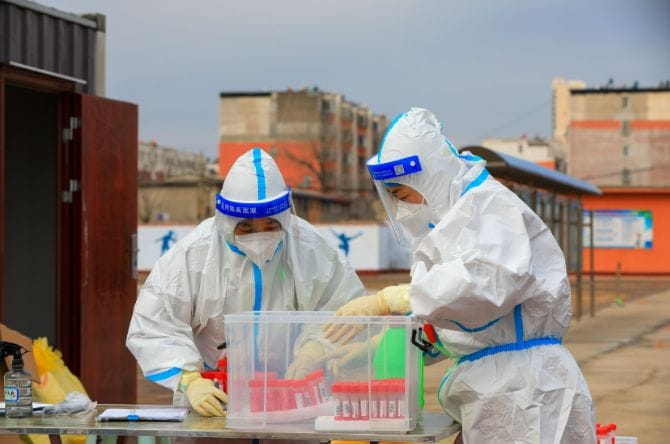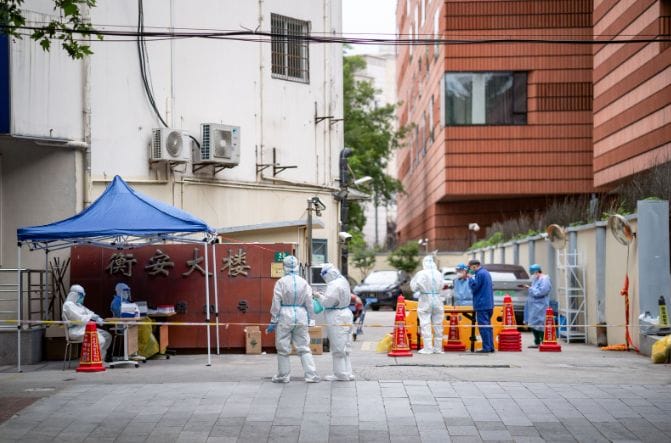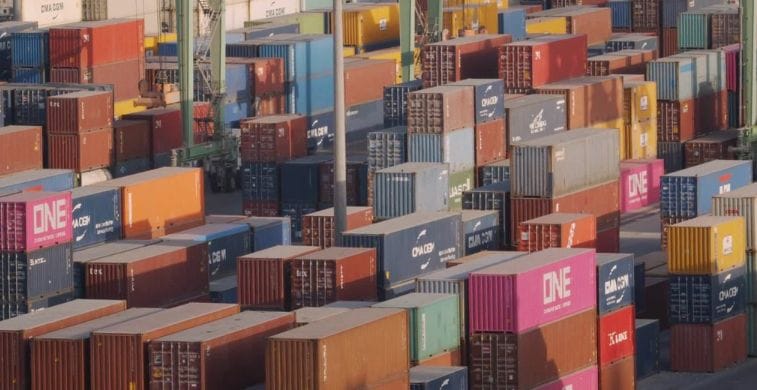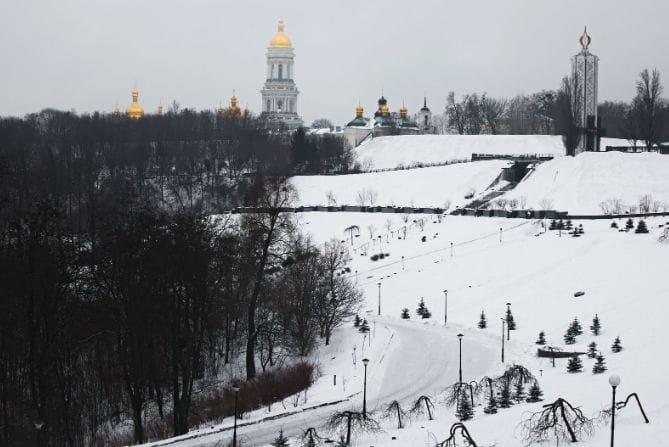“If we could unfold the future, the present would be our greatest care” – Edward Counsel
Every year we release a blog of the top 10 threats you will likely face in the next year. More or less, each one plays out or comes close to playing out to some degree. We don’t want to be 100% right, believe me, and our intent is not to scare you. We strive to take an unbiased and sober look at the genuine threats to your safety and security in the coming year without the soundbite arguments and punditry that does nothing for our preparedness.
We are already seeing some of the ten threats we will face in 2023 playing out right now. Some we are rolling right over from last year, because they are still threats, often of a more significant scale. If there’s one blog you absolutely must watch and share with your friends, this is it. Here are the top 10 threats to our safety and security in 2023.
Russia/Ukraine
 While the war, at the time of writing this blog seems, to be at a stalemate of sorts heading into winter, the potential for a strategic nuclear strike remains a possibility. Putin’s options are rapidly dwindling after not speedily attaining a victory in the early days of his “special operation” in Ukraine. There don’t seem to be any apparent off-ramps to de-escalate this war, which is dug in the trenches like the last 3 ½ years of World War 1.
While the war, at the time of writing this blog seems, to be at a stalemate of sorts heading into winter, the potential for a strategic nuclear strike remains a possibility. Putin’s options are rapidly dwindling after not speedily attaining a victory in the early days of his “special operation” in Ukraine. There don’t seem to be any apparent off-ramps to de-escalate this war, which is dug in the trenches like the last 3 ½ years of World War 1.
Also similar to World War 1 are reports that lice have broken out in at least one behind-the-lines concentration of Russian soldiers. Of course, there are far better chemical remedies now than then, so the Russians can still get this under control. However, parasites can alter the course of the war. Lice and typhus saved Russia from Napoleon.
Use of nuclear weapons or the horrors resulting from trench warfare are all possible. Also, it is possible Russia may continue its attacks on civilian infrastructure through the expanded use of bombers. The Russian supply of missiles is running low, and sourcing parts to build more is difficult with a reduced labor pool and international sanctions. As a show of solidarity, Russian and Chinese bombers flew a joint patrol in the Pacific and then, for the first time, landed at each other’s bases. To be clear, Russia still has missiles, and there are rumors that it is actively planning another massive strike right now.
There are lots to follow in this war, even through winter, but the biggest story will be the Ukrainian people’s struggle to survive. With 70% of their civilian infrastructure damaged, agricultural output reduced, and a brutally cold winter settling in, it will be challenging for many to survive. Whether this winter will be on par with the Holodomor in the same area during the 1930s remains to be seen.
Indeed, this war will continue to drag down the global economy, drive prices for everything upwards, and create real hunger and famine issues for many countries worldwide.
Recession

At the time of writing this blog, we are, by most measures, in a recession. All indicators point to more and more profound pain points in the coming year, and it’s essential that people begin or continue to prepare for this possibility. Even if that’s not a big deal for you, it will be for the majority of your neighbors. Household debt has doubled over the last decade, and 63% of Americans live paycheck to paycheck. That’s not just low to middle-income workers, either. Nearly half of the six-figure earners are living paycheck to paycheck as well. Think about that for a minute.
As the economy continues to slide and inflation continues to drive up prices, your hard-earned money will buy less and less. This is a teetering house of cards that will take some time to stabilize. It will almost certainly worsen in 2023, and any improvement will be in the following years.
Real Estate Correction
 One of the inevitable victims will likely be real estate. The market has appeared to top out. With multiple downward pressures like higher interest rates, inflation, and a rise in unemployment, the potential for a correction is increasingly looking like a given.
One of the inevitable victims will likely be real estate. The market has appeared to top out. With multiple downward pressures like higher interest rates, inflation, and a rise in unemployment, the potential for a correction is increasingly looking like a given.
If it will be as bad as 2008 remains to be seen. We have different conditions than then when the entire financial structure underpinning the housing market was built on subprime loans which rapidly ballooned crashing the whole house of cards. We have previously warned of a commercial real estate crash, which is still a very real possibility. According to most analysts, the potential for a residential real estate correction is growing daily. Existing home sales have dropped for nine straight months. Many homeowners refinanced when rates were low. Unemployment at this moment, is still relatively low, so it isn’t likely we will see a surge in defaults next year. We will undoubtedly see a price correction and a slowdown of new builds, though. How much of a correction is yet to be seen.
China’s Internal Problems
 China continues to face multiple issues within its borders. Their Dynamic Zero-COVID policies and lockdowns are leading to small protests that are being countered by heavy-handed authoritarian rule. You will want to read our most recent blog, where we dive deep into this and assess whether it will lead to any substantive change in the country. Their internally-developed vaccine is proving less than effective, especially against new, more virulent strains. While it may be a point of national pride not to source vaccines from other countries, the real reason they don’t maybe the economics. At a cut-rate government price of $19.50 per dose for the Pfizer or BioNTech vaccine, it would cost China the equivalent of nearly 3% of its GDP just to vaccinate their population with two doses. Obviously, they have taken a different route in trying to quash outbreaks.
China continues to face multiple issues within its borders. Their Dynamic Zero-COVID policies and lockdowns are leading to small protests that are being countered by heavy-handed authoritarian rule. You will want to read our most recent blog, where we dive deep into this and assess whether it will lead to any substantive change in the country. Their internally-developed vaccine is proving less than effective, especially against new, more virulent strains. While it may be a point of national pride not to source vaccines from other countries, the real reason they don’t maybe the economics. At a cut-rate government price of $19.50 per dose for the Pfizer or BioNTech vaccine, it would cost China the equivalent of nearly 3% of its GDP just to vaccinate their population with two doses. Obviously, they have taken a different route in trying to quash outbreaks.
Locking their citizens in high-rise apartment buildings or hundreds of thousands of workers in factories will not play out too well for them, we imagine. It also can increase the concentration and spread rate in these enclosed, multi-generational environments. That can build some natural immunity in a population, but it can also give rise to spinning off more virulent and deadly mutations of the virus. They can try and contain it, but the tighter their grip on it, the more likely it will spill out into the world. We may see yet another variant from China this next year. If we don’t, the odds are that the toll on their own population will be incredibly high, even though the currently reported numbers are very low.
Internally, China also faces a real estate crisis and a $900 billion railway debt problem. They keep kicking these problems down the road, but they exacerbate the country’s other issues. The rest of the world will see China’s productive output and growth continue to decline. To compensate, China will build stronger economic and diplomatic relations with Russia.
China’s External Problems
 We decided to split this one off as it needs its own discussion away from the country’s internal conflicts. China continues to have territorial aspirations for the Kinmen Islands, Taiwan, South Pacific areas, and even Siberia, a region bigger and richer in resources than any place on Earth. A Russian failure in Ukraine could cause the Russian Federation to atomize, and Xi Jinping knows this.
We decided to split this one off as it needs its own discussion away from the country’s internal conflicts. China continues to have territorial aspirations for the Kinmen Islands, Taiwan, South Pacific areas, and even Siberia, a region bigger and richer in resources than any place on Earth. A Russian failure in Ukraine could cause the Russian Federation to atomize, and Xi Jinping knows this.
The only thing keeping China from acting on its impulses is the pressure from its two biggest customers, Europe and the United States. Still, as any astute business person might do, Bejing has forged extensive new alliances and commerce deals with Moscow. This will change the dynamic and could topple already strained and weak partnerships. Now might be a good time to blow the dust off your old Risk board and refamiliarize yourself with Mongolia, Irkutsk, and Kamchatka, because they may be in play this next year.
Even if there isn’t an overt land grab on China’s part, you can expect economic deals to be struck and supply chains to the rest of the world to be strained further, perhaps even weaponized. The same wavering alliances and strained relationships are likely to bubble up in India as it seeks to equalize its import-export relations with Russia to provide manufacturing to Russia and receive oil. The business alliances and priorities are shifting with these two most populous countries in the world. China produces 30% of the world’s manufactured goods, from cell phones to massive municipal water pumps and transformers. India exports $84.9 billion worth of petroleum byproducts, biochemicals, and pharmaceutical ingredients.
If these alliances shift towards Russia, the supply chains will snap worldwide. If the world maintains stability through this next year with China and other countries, it still is an explosive enough dependency that we will be following it for years to come. Xi Jinping is playing a very long game, sitting on the fence, and will strategically move when he can advance the communist country’s agenda the furthest, regardless of the damage that may inflict on the rest of the world.
Energy & Infrastructure Failures
 Between the concern about diesel shortages and the problems Europe is facing with Russia cutting supplies, we need to begin preparing for the real possibility that energy shortages and price increases will increasingly become the norm. These issues will only exacerbate the supply chain problems we’re currently facing. Europe will struggle as its existing reserves dwindle, and it will turn to West Africa, Qatar, Saudi Arabia, and green energy to try and compensate for the next decade of shortfalls.
Between the concern about diesel shortages and the problems Europe is facing with Russia cutting supplies, we need to begin preparing for the real possibility that energy shortages and price increases will increasingly become the norm. These issues will only exacerbate the supply chain problems we’re currently facing. Europe will struggle as its existing reserves dwindle, and it will turn to West Africa, Qatar, Saudi Arabia, and green energy to try and compensate for the next decade of shortfalls.
That will continue to play out over the next several years, even as we in America increasingly see our own infrastructure systems continue to fail. Whether it’s winter or summer brownouts, blackouts, prolonged power outages, or unsafe drinking water, pipelines, or fuel supplies, this decade will be earmarked in the history books as a time with some rather epic infrastructure failures. We have seen several unimaginable examples already over the last few years, and we would be naive to think we won’t see more, compounded by some of the other problems I have already elaborated on earlier.
Even countries with abundant natural resources will see their citizens struggle to afford them, as all resources flow to the highest international bidder and often end up far from their origin. Countries with seemingly great infrastructure systems will suffer, as well, as oil and natural gas supplies run low or aging systems can’t get the parts needed for upkeep and maintenance.
Supply Chain Problems
 The last few years have shown us just how interconnected, interdependent, and vulnerable the supply chain really is, and 2023 will expose more cracks and flaws in the tightly wound, just-in-time manufacturing system and its distribution. 2023 will bring with it more political unrest, a lack of raw materials, reduced agricultural output, rising fuel, energy, and transportation costs, and inflation. These will all hammer away at the supply chains.
The last few years have shown us just how interconnected, interdependent, and vulnerable the supply chain really is, and 2023 will expose more cracks and flaws in the tightly wound, just-in-time manufacturing system and its distribution. 2023 will bring with it more political unrest, a lack of raw materials, reduced agricultural output, rising fuel, energy, and transportation costs, and inflation. These will all hammer away at the supply chains.
The top three supply chain disruptions industry leaders expect in the U.S. in 2023 are the reduced availability of raw materials, a slowdown in new home construction, and a disruption of transport due to a lack of drivers. These three will be challenges enough for economies struggling to get back to pre-pandemic growth. If there is even one compounding factor like an expansion of the war in Ukraine, saber-rattling by China, strained trading relations, or any significant natural disaster or world hunger crisis, the supply chain will strain even further.
If you or your community sources anything from anywhere overseas, 2023 could have you struggling to find what you need, just like during the darkest days of the pandemic.
Increased Weather Anomalies
 2022 has seen its fair share of weather patterns that have broken records. Heat waves and records have been set again, and we will see new record lows in the northern hemisphere this winter. Multi-decade droughts in some areas of the world and deluges in others will continue to reduce agricultural output.
2022 has seen its fair share of weather patterns that have broken records. Heat waves and records have been set again, and we will see new record lows in the northern hemisphere this winter. Multi-decade droughts in some areas of the world and deluges in others will continue to reduce agricultural output.
Expect 2023 to set some new record highs, lows, precipitation shortfalls, and record deluges. Glaciers are continuing to recede. The overall temperatures continue to climb degree by degree. Many of the models that the scientific community has been warning about for years is starting to play out at even a more rapid pace. We should not dismiss these weather anomalies as a one-off, especially when they are happening year after year with increased frequency. We would be wise not to dismiss them as every merely just once in a century, millennium, or solar cycle events. Undoubtedly the comment section will be filled with debate on these issues, but the wise will observe the reality of what is happening before their eyes, pivot, and learn to survive through the changes. Even if the drought a thousand or ten thousand years ago was worse, the population’s concentration and dependence on water in that specific area weren’t as great as they are today. Agriculture had not yet had its Green Revolution that led to mass farming operations, large-scale usage of fertilizer and insecticides, and bumper crops.
The weather doesn’t even have to get worse this next year for us to experience problems that will directly impact our lives. If the weather were exactly the same in the coming year compared to 2022 for every degree of temperature, every day, and every drop of rain, we would continue to move toward predicaments that will impact our lives, that again, we’ve been warned about. Experts say it would take at least two solid years of bumper crops to stabilize current global grain supply level demands which leads us to our next point.
Increased Food Prices
 We did a much deeper dive into food prices this next year in a recent video. On average, food prices have been up 12% since August, and after watching that video, you will probably agree that food prices will climb much higher in 2023. They could rise 30-40% higher from where they are today in this next year.
We did a much deeper dive into food prices this next year in a recent video. On average, food prices have been up 12% since August, and after watching that video, you will probably agree that food prices will climb much higher in 2023. They could rise 30-40% higher from where they are today in this next year.
Food prices and food insecurity are two reasons we are launching a video series on gardening and cultivating your own food sources in small spaces like apartment balconies or indoors. We are not guessing that food prices will continue to go up next year. We are telling you with great certainty that they will. Please pay attention to this and formulate a plan to store food and most importantly, how to grow your own food. While growing your own food does have an initial up front cost, the key is to begin learning now. Becoming proficient at gardening takes time, which is a luxury you do not have. we would encourage you to follow along with our gardening playlist if you have a small space to grow a garden.
Food remains the top vital prep, and the world will suffer from high costs, reduced output, and failing supply lines. We are leaving a period of wide variety and abundance and will struggle next year in big and little ways with everything from seed, to harvest, to processing, transport, retail, and table. Please take your food security seriously now to lessen the impact of these failings in the next year.
Government Gridlock
 We try to steer clear of politics on this channel, but we would be remiss if we didn’t address it from time to time on this channel in as non-partisan of a fashion as we can. The reality is that politics impact our daily lives. With the recent elections, the House leans Republican, and the Senate remains under the control of the Democrats. Neither party has 100% control and uniformity in votes over their own members.
We try to steer clear of politics on this channel, but we would be remiss if we didn’t address it from time to time on this channel in as non-partisan of a fashion as we can. The reality is that politics impact our daily lives. With the recent elections, the House leans Republican, and the Senate remains under the control of the Democrats. Neither party has 100% control and uniformity in votes over their own members.
The political landscape remains divided as a whole and even divided between more moderates and extreme viewpoints within the parties. If you recall the government shutdowns of 1995, 1996, 2013, 2018, and 2019, you know how damaging they can be to the economy. These hyper-partisan divisions encourage shutdowns as a tactic to stall, stop, or modify current and pending legislation. We will likely see more shutdowns, subpoenas, investigations, partisan rhetoric, and gridlock. We will also see less compromise, governance, and an atmosphere of working together.
These government divisions will be further stoked and encouraged by a struggling economy, labor strikes, and global challenges. We are reminded of Thomas Jefferson’s quote: “The government you elect is the government you deserve.” We don’t expect things to improve this next year. We’ll see a very divided political landscape, like our nation’s population.
Conclusion
Those are the ten pain points we see in this next year, as succinctly as we can summarize them. There are always more and more that can be said. Conflicts from Iran to Myanmar continue to fester worldwide, and each can hammer away at the whole of global stability. We will keep monitoring them. In some ways, 2023 will be better than 2022. In other ways, it will be far worse. We honestly hate to say that out loud, but as we always try to point out, we think being honest and realistic is an important starting point. Any one of those ten things could escalate into a much larger and more impactful crisis. Fortunately for us, there is a common solution to mitigate the impact of these things on our daily lives.
Next week, we will release a blog on five things you could be doing right now to prepare for and make your 2023 better. We’ll give you a hint. It has to do with prepping, which is the whole point of this channel. In that blog, we will provide you with reasonable, actionable things you can do to free yourself from dependence on supply chains, infrastructures, and economies that, even if they don’t fail, can drag us down as they stutter step. Watch for that blog or subscribe to the channel to see when we release it.
Is there anything we missed here? Do you see a threat we haven’t covered? Tell us in the comments below, and maybe we will make it a future blog topic.
As always, stay safe out there.

